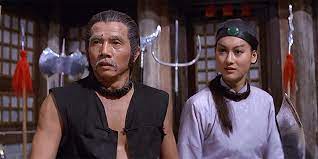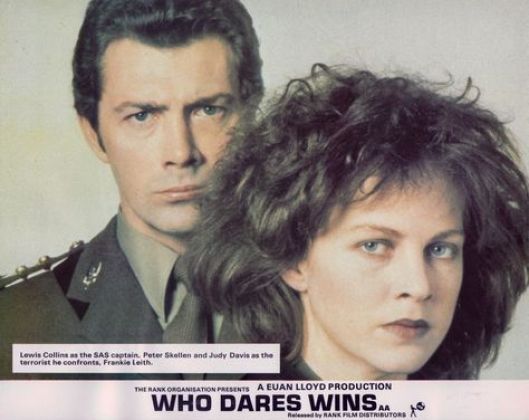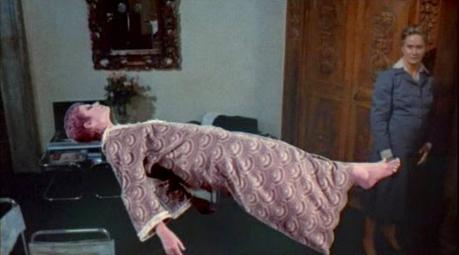« January 2022 | Main | March 2022 »
February 15, 2022
Legendary Weapons of China

Shi ba ban wu yi / Sap bat bun mo ngai
Lau Kar-leung - 1982
88 Films BD Regions A/B
First, an editorial decision - while the film is credited to director's Mandarin name of Liu Chia-liang, I will be referring to him with the better known Cantonese name. Also, the actors will be referred to by the names more familiar to western viewers.
David West, author of a book on martial arts films, offers the best key in understanding Legendary Weapons in his brief video supplement. The film was produced at a time just before Shaw Brothers Studios was not only rampling down production of martial arts films but also tapering off theatrical film production in general. Lau Kar-leung made a film that could be read simultaneously as a historical commentary on how martial arts and nationalism were no match for European guns during the Boxer Rebellion, and also a deconstruction and satire of a genre that Lau played a major role in creating.
The rambling plot is about a trio of martial arts disciples who seek out a kung fu master accused of being a traitor for disbanding his group of spiritual boxers. There is no straight line, but rather a series of diversions and detours leading up the final showdown of brother against brother. Parts of the film serve as showcases for the talents of Gordon Liu, Kara Wai, Hsiao Ho and especially Alexander Fu Sheng. Lau stars as the reclusive martial arts master with his real life brother, Lau Kar-wing, as brother and nemesis. Alexander Fu Sheng gets to play against his more typical screen heroism as a street performer and conman who gets into a sword fight that included him spilling his obviously fake intestines, stopping to stuff them back in his stomach before resuming his battle.
Lau opens the film with his stars and stunt crew performing on an empty black stage. The demonstrations of various weapons and the fight choreography are filmed with shots held long enough to see various complex movements all done without the benefit of editing. As in the fight scenes within the main narrative, the shots here are primarily full or medium shots, somewhat analogous to how Fred Astaire would have his dance scenes filmed. Compare this to traditional Hollywood films where sword fighting was often broken down to three strokes per shot, or the more contemporary films with action filmed and edited in a series of very brief shots. Lau was 47 years old when he directed and starred in this film, with his brother ten years younger. The final fight scene with the two using the various legendary weapons is impressive not because of the weaponry but the sheer physicality of the two brothers.
Aside from David West's supplement, this new blu-ray comes with three commentary tracks, plus two additional videos by French videographer/interviewer Frederic Ambroisine. I listened to two of the commentaries. The first, from Mike Leeder and Arne Venema is a casual conversation that covers the careers of the director, and some members of the cast and crew. One of the more interesting points brought up was that the Shaw Brothers films of the time were all post-dubbed into both Mandarin and Cantonese versions, and that even the Hong Kong based actors did not always use their own voices in the films. The blu-ray comes with English and Cantonese language tracks. Leeder and Venema mention their disbelief that Kara Wai would pass as a young man as she does in most of the film. My own view is that Wai's role is part of a tradition that includes the various versions of Mulan and Chinese opera stories like The Love Eterne with women disguised as men, where what the audience sees is secondary to the viewpoint of the characters. Frank Djeng does double duty with two commentaries. One is with martial artist and actor Michael Worth. I listened to the second with Djeng providing more cultural context to the story as well as the history of the Shaw Brothers.
Fred Ambroisine's 2004 interview with Associate Producer Titus Ho is enlightening regarding the production methods at the Shaw Brothers Studios during their peak. While Mona Fong was the one getting the main credit, there would be six producers who would be directly responsible for a slate of about forty films per year. Also shooting schedules could run as long as three or four months. Also from 2004 is Ambroisine's interview with Gordon Liu. Usually an intimidating presence on screen. Liu, speaking about his career comes across as warm, even cuddly. A personal admission here - I do not know if it made the final cut, but I have corresponded with Ambroisine since meeting him at the Far East Film Festival in Udine, Italy in 2014, and participated in a video greeting to Liu.
The blu-ray is sources from a high definition remaster from the original 35mm negative, with new English subtitles. The first pressing also include booklet notes by Andrew Graves plus a full-sized poster.
Posted by Peter Nellhaus at 05:46 AM
February 08, 2022
The Final Option

Who Dares Wins
Ian Sharp - 1982
KL Studio Classics BD Region A
First, I will say that I think the original British title is so much better than the generic title provided for the U.S. release.
My interest in checking out this Reagan era artifact is that I had read that star Lewis Collins was once considered for the role of James Bond. Reportedly, Collins was rejected for being "too aggressive". He might have made an interesting choice. In The Final Conflict he seems capable for the action scenes but most of the comes across as glum, cold and smug. Collins is the hero, going undercover to infiltrate a group of political terrorists that have used the cover of a respected anti-war group for their own hidden agenda.
Judy Davis provides the screen charisma here, somewhat improbably cast as an American activist with a lion's mane of a hair-do, and the conviction that diplomacy works better from the barrel of a gun. Davis' plan is to hold a group of diplomats hostage to force the British military into nuking a submarine base in Scotland. By having the bombing televised, people would understand better the destructive capabilities of a single nuclear bomb - or so the theory goes. The Final Option takes place in a parallel universe where documentary footage of Hiroshima and testing at the Alamogordo Bombing Range does not exist.
Richard Widmark is on hand in the latter part of the film as the U.S. State Department chief, one of the hostages, who attempts to point out the errors of her logic to Ms. Davis. There is also Ingrid Pitt as a particularly merciless terrorist who makes a point of making life miserable for anyone within shooting range. And while some of the political biases of the film are obvious, especially forty years after the initial release the politics are almost besides the point. To watch The Final Option now might be considered analogous to watching a Cold War film from the early 1950s informed by the paranoia of Commie subversives where the intrigue and adventure are still entertaining while the topical events that inspired the film are no longer relevant.
The blu-ray includes a commentary track by producer Euan Lloyd and director Ian Sharp from 2002. Rosalind Lloyd, daughter of the producer, who has a supporting role, also makes a brief contribution. The commentary track and the supplementary documentary, from 2004, on Euan Lloyd's career are good examples of the producer as auteur. Aside from originating the theme for The Final Option, the film is a reflection of his admittedly center-right politics. Lloyd culled director Sharp and star Lewis Collins from the British television series, The Professionals. According to Lloyd, MGM lost interest in supporting the film when it became known that Ronald Reagan spoke highly of it following a requested preview. There may be some truth to that although at the time of release, MGM was in a precarious state with a revolving door of financiers and executives in charge, and huge losses from most of the few films in release. As for Lloyd's politics, he had had no problem working for the blacklisted Carl Foreman in the early 1960s. There is also the production of A Poppy is also a Flower on behalf of the Untied Nations. The Wild Geese was the subject of contention having been filmed in apartheid South Africa, though with a racially mixed cast. Lloyd did make certain to have the film premiere in Soweto where it proved to be popular. In the supplemental documentary, Last of the Gentlemen Producers, star Roger Moore and singer Joan Armatrading share their experiences and thoughts on The Wild Geese. Something not explained is why Lloyd retired at age 62 following production of The Wild Geese II. It may have been that the challenges of being an independent producer had outweighed the rewards. The documentary on Euan Lloyd's life showed that there was almost as much drama in producing a film as would be seen on screen.
Posted by Peter Nellhaus at 06:14 AM
February 01, 2022
The Antichrist

L'anticristo / The Tempter
Alberto De Martino - 1974
KL Studio Classics BD Region A
As a general rule, I usually do not watch horror films involving exorcism. The one big exception is The Exorcist. Not being Catholic, or Christian for that matter, the theological aspects can be interesting on an intellectual level. Otherwise, I do not feel compelled to watch a young woman going through various physical contortions until the priest with arcane knowledge and rituals shows up.
The Antichrist might be described as the story of the power iconography. The film starts off, documentary style, with pilgrims praying to a shrine of the Virgin Mary. The shrine is protected by a cage. Just outside are a small group of people with various mental or physical maladies, hoping for the miracle cure, by prayer or touching the statue. Crosses, whether in the form of a personal crucifix, statuary, or the kind smudged on the forehead, all appear here. Even church bells take on added significance.
More of interest to me is the iconography of the cast. A number of 1970s Italian genre films would have a cast mixed with European actors who sometimes had more artistically ambitious work in their careers, along with older Hollywood stars who kept their careers going by going abroad. The film stars Carla Gravina as a woman who suffers from paralysis in her legs due to a childhood trauma, and then through hypnosis discovers she was a witch in a previous life. And honestly, my only motivation for seeing The Antichrist was for Ms. Gravina. It was seeing two films within a short time of each other, Claude Lelouch's And Now My Love and Duccio Tessari's Tony Arzenta, released in the U.S. as No Way Out, where Gravina caught my attention. In the first film, she plays the girlfriend of Marthe Keller, in the second, the girlfriend of Alain Delon. Red hair and a face full of freckles, of course I had a crush on her. Gravina's stardom may have been limited primarily to Italian films, but she has a handful of acting prizes, including Cannes, along the way.
Supporting Gravina are Mel Ferrer as her father, and Arthur Kennedy as her uncle who also happens to be a ranking priest in the Vatican hierarchy. Both actors at this time were frequently seen in Italian genre films, usually as authority figures. Younger viewers might be unaware of a time twenty years ago when Ferrer was a romantic lead while Kennedy was a much respected actor on his way to five Oscar nominations. It was about twenty years earlier that Alida Valli made Senso with Luchino Visconti. What also probably attracted filmmakers to casting Ms. Valli was her history of starring in films by Alfred Hitchcock and Sir Carol Reed, even if she no longer resembled the woman once compared to Greta Garbo and Marlene Dietrich. As the priest doing the exorcism, Orson Welles associate George Coulouris takes on that task.
For the horror film fan, there is ritual sex with a demon, flying furniture, exploding lamps, the voice of the devil, spitting of green liquid, and the usual bag special effects moments. In the supplement ported over from Blue Underground, shot in 2002, De Martino cheerfully admits there would be no Antichrist without The Exorcist. Fortunately, there is enough difference to keep the film from looking like a lazy imitation. Something I did not expect was a level of elegance in the sets and cinematography. Also included in the brief supplement is an interview with Ennio Morricone, who shared composing credits with Bruno Nicolai. Morricone reveals himself as the author of the atonal violin score heard at various dramatic points.
The commentary track is casually conversational, between two Australian film critics, Lee Gambin and Sally Christie, who have both specialized in genre films. Their discussion ranges from Catholic ritual to some of the other work of the primary cast and crew. Another supplement in the opening credit for the film when it was released as The Tempter. I do want to advise anyone unfamiliar with The Antichrist as I was that while the blu-ray offers both Italian and English language soundtrack options, the first nine and a half minutes are in Italian with no subtitles. That particular sequence is the documentary style opening prior to Gravina and Ferrer isolated from the frenzy of the crowd.
Posted by Peter Nellhaus at 06:01 AM
